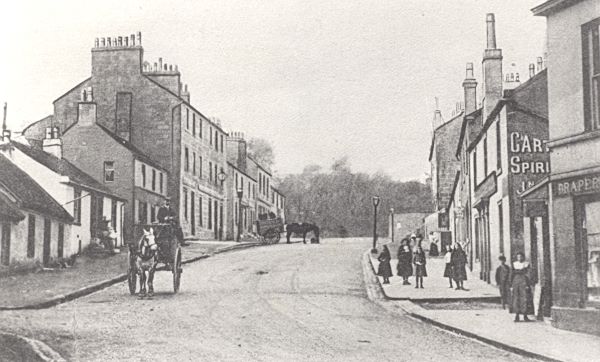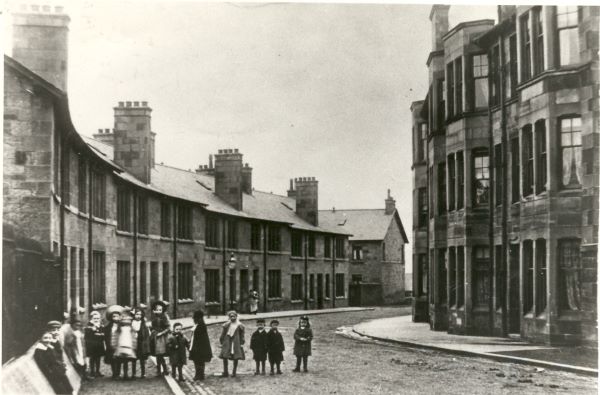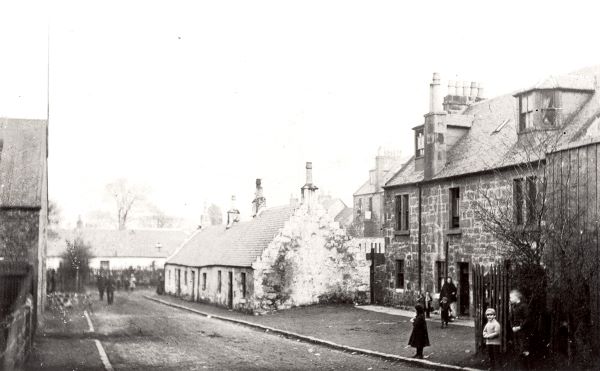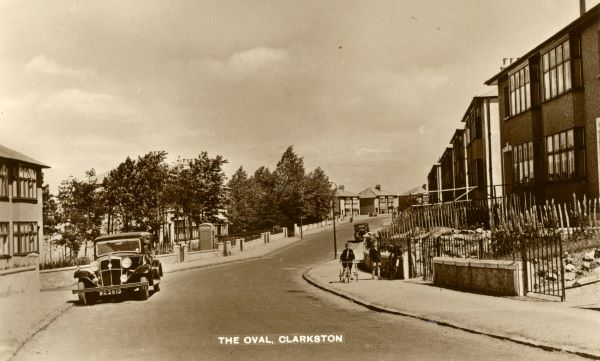

Housing
Housing
Pre-industrial East Renfrewshire was a mainly agricultural society, with a scattered population living in small ferm-touns as wells as a few villages with a more concentrated population. Rapid changes in agriculture, industry and society from the mid 18th century onwards has led to today’s East Renfrewshire with its busy towns and villages and its residential suburbs. This article explores that journey with links to other articles of interest.
The Industrial Revolution
From the mid-eighteenth century this area went through some dramatic changes which would transform the landscape forever. Firstly, as agricultural methods progressed, there was a move to enclosed farming. This meant that the small holdings, once farmed by families and small communities, were consolidated into larger enclosed farms under the management of one farmer. Although this improved production, it created surplus labour, as not all those who were displaced would find employment within the new way of working.
However, at the same another great change was happening all over Britain. The Industrial Revolution created new towns and villages, which grew around mills and printworks, established to feed the booming textile industry. Some of the those displaced found employment in these factories, which offered better wages than agricultural labour. In areas like East Renfrewshire which had a profusion of these works, it brought about a rapid increase in the population, with people coming from far and wide, lured by the prospect of employment.
Of course, where you have an increase in population, you also have a corresponding need for more housing. Mill and print work owners began to build workers’ housing close to their factories which they would rent to employees. This was very much the case in Busby and Thornliebank; two villages which did not exist in any real capacity prior to the industrial revolution, but which quickly became busy industrial hubs.
By 1854, Busby was a thriving and significant textile village, with two cotton mills, a large calico printworks and a population of well over a thousand. The owners of these factories had houses built for them; largely two-storeyed terraces, usually referred to as Lands. Wallace Land, Nelson’s Land, Lang Land, West Land, Carswell’s Land were owned by the cotton mill owners and housed their workforce, whereas, Church Land, Struther’s Land, Printer’s Land, housed the workers from the printfield. Two-storeyed terraces were also built in Burnside Terrace, now Riverside Terrace, and Durham Terrace. Typically, multiple families would be crammed into these tenements, each family occupying perhaps one or two rooms.

Some cotton mill workers were housed at Smithy Row, a two-storey cottage terrace with a thatched roof, which was situated where Lower Mill Road is today. The Lower Mill, where they worked, would have been only 100 yards or so from their doors.
The village of Thornliebank was first developed industrially in 1778 when Robert Osburn, a linen printer, attracted to the area because of the pure water supply, leased a piece of land and founded the first printfield. Osburn was the catalyst for the beginning of a workers’ village and by 1789, a little street of cottages was in existence and there were a few two-storey buildings. This little hamlet of Thornliebank was in the area, which was later developed as mills, on the boundary between Thornliebank and Crosslees farm, and not the area of the present day Main Street.
John Crum then bought the premises for his sons, Alexander and James, to accommodate their expanding calico printing business based in Gallowgate, Glasgow. The success of the Crum brothers’ business brought about a huge rise in the number of workers employed in the village, from 50 employed by Osburn’s business in the latter half of the eighteenth century, to 847 employed by the Crums in the first half of the nineteenth century.
Towards the latter part of the 19th century, the health of the Thornliebank villagers was generally better than others, possibly the result of a sewage system installed by Alexander Crum, which provided good sanitation. Amongst other things, Alexander was also responsible for the planting of many trees and the employment of a village doctor.

In 1893, plans for new blocks of houses, consisting of two rooms and kitchen, were submitted by the directors of the Company, for approval. The houses were said to be very comfortable and they also had gas and water installed. The Crums had a great influence on many aspects of village life, as well as good housing, they were responsible for the provision of educational and recreational facilities in the village; they built the village hall and public baths, village park and library, and were associated with the building of the Thornliebank School in 1875.
The railway
From the 1860s, the villages and towns in this area also saw an increase in larger, more expensive dwellings which coincided with the construction of the railway lines. Though the railways were originally built to take cargo in and out of the mills, printworks and factories, rather than passengers, their potential for allowing people to live in places like Giffnock, Clarkston and Busby was quickly realised. A local station meant that it became only a quick journey to the centre of Glasgow and those with a higher income started to purchase plots of land and houses here, to escape the grime and hectic nature of the city. At that time, East Renfrewshire was very much seen as a countryside location with healthy clean air and a idyllic village existence.
Builders and individuals began to feu plots of land for building. Large villas and sandstone terraces began to spring up, firstly along main roads and around the railway stations to allow ease of access to travel. The ad hoc nature of this development has led to some streets having a variety of designs and architectural styles, while other streets which were bought by builders have a more uniform appearance. These attractive family homes laid the foundation of many of our local areas as residential suburbs.
The Interwar Period
Although Alexander Crum had brought better housing to Thornliebank this was not the case elsewhere. Workers’ housing was generally crowded and unsanitary. and during the 19th century outbreaks of Cholera and other diseases were common. World War I brought with it a deterioration in housing conditions and higher rents, causing rent strikes and protests. In 1919 the Prime Minister, Lloyd George, had pioneered homes for heroes for the men returning from the First World War. Lord Weir commented on what he regarded as a serious housing crisis in the 1920’s “the present shortage of working class houses is not only a national calamity…but a pressing national danger”.
The Government under Lloyd George brought in the Addison Act (1919) which was supposed to encourage Local Authorities to build affordable houses and the 1920s saw a great number of council houses being built all across Britain.
In Barrhead, the Town Council were under pressure to improve housing as, by the end of the war, many of the tenements in the town were unsanitary and overcrowded and were only fit to be condemned. The first attempt to provide better housing under the Addison Act led to a small number of council houses being built on a strip of land along Arthurlie Street and Weir Avenue. In the end, these failed to solve the problem of housing the most needy families. The council set rents at too high a level for most people to afford and they went to those who had decent wages and were already occupying the better tenements.

In 1921, another scheme was started at Kerr Street and Blackwood Street, but this too housed the better-off tenants. In 1925 the Bowerwalls scheme was planned to replace the existing housing which had deteriorated into slums. These were smaller, cheaper terraces built at the edge of town, which were offered at a lower rent. The late 1920s also saw the building of Commercial Road and of the much larger Arthurlee Estate which consisted of over 200 homes.
The increase in council houses was not limited to Barrhead. Busby saw the building of council houses in the 1930s, 50s and 60s. Hawthorn Road and houses in Birch Avenue, Birch Crescent, Cartsbridge Road and Elm Street were all built in between the two world wars. Cartside Road, Mossgiel Crescent, Ellisland Road, and some of Oliphant Crescent, Southview Avenue and Lochlea Roads were constructed in the 1950s.
Post-war housing
World War II brought a stop to much of the house building in East Renfrewshire. Post war, the building of council houses continued, but in the 1930s there was a private house building boom which completely changed the shape of our towns and villages. Companies like Mactaggart & Mickel, began to buy large tracts of land from local farmers and create vast housing estates. This is nowhere better demonstrated than in Clarkston. In the 1930’s over 3,000 private houses (80% of those in the whole area) were built in Clarkston. The vast majority of these were either two-storey semi-detached villas or detached and semi-detached bungalows, built to a limited number of designs.
One of the first of these housing estates was Carolside Park, acquired from the Williamwood Estate by Mactaggart & Mickel Ltd, who had been associated with building in Clarkton since 1909. They built semi-detached homes and four-apartment bungalows. John Lawrence Ltd was another company involved in house building during the 1930’s in Clarkston. The company bought 98 acres of land in Clarkston, in the Williamwood area, and a large housing development took place from Kilpatrick gardens up to Clarkston Centre, that is, the area bounded by the Williamwood to Whitecraigs and the Giffnock to Clarkston railway lines. Lawrence also built semi-detached and terraced houses, at Stamperland. Also building at Stamperland were James Wright of Cathcart and builder John Dickie was also active in the area.

Other areas too grew quickly through private developments. The 1930s saw many bungalows being built to line the Ayr Road up to Mearns. Mactaggart and Mickel built the exclusive Broom Estate in Mearns, and in Giffnock, they created the vast Orchard Park Estate. All of this building activity firmly cemented East Renfrewshire’s identity as a residential area and this pattern continued on throughout the century.
Most of the early housing developments have stood the test of time and today East Renfrewshire has a great variety of housing of all ages and styles. It continues to be a sought after residential area and new housing developments continue to appear regularly contributing to the ongoing change of our local landscape.
